Exploring the Origins
of
Easter, the Easter Bunny, and Colored Eggs

I always try to include some history in with the recipes because I truly believe
that food tastes better when you know some background behind it.
Music always sounds better to me also when I know something about the background
of the musicians and where and when the song was composed,
and the serendipity and accidental surprises that often are lead to it's origin
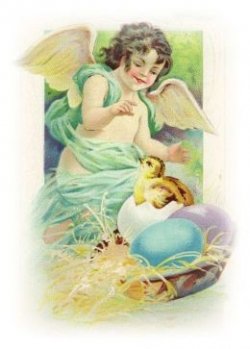
I started this newsletter a week ago and wanted to just research a little
about the origins of the Easter Bunny and hunting for colored eggs
a few hours turned into a week, and as it is with anything your curious about,
the more research you do the more questions you have,
and the more dig deeper and wider and all the sudden you have so many
wonderful nuggets of fun and wonderful information and images,
and it feels insurmountable to organize them in a way to share.
So I came to the conclusion of just giving you a handful of nuggets and images
and if your interested you can dig with me, and I would love you to share with me.
a few lines are only a taste and doesn't really give you that "Thrill of History"
and enough to make a full meal to digest.
First of all the the origin of the Easter Bunny has many many versions and
still no one really knows as far as I am concerned,
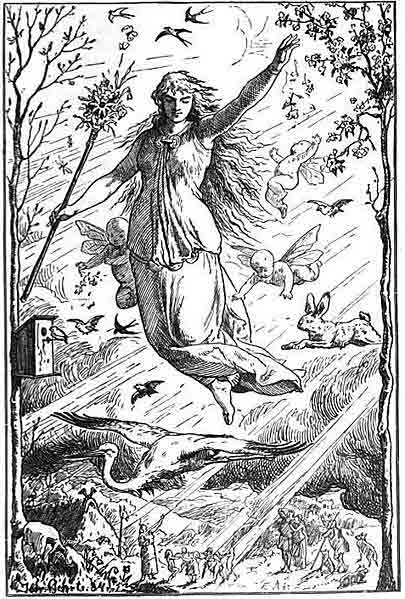
Oester the Anglo Saxon Fertility Goddess
Did the Easter Bunny and Easter Eggs originate from pagan rituals?
Our great great to the X-power grandpa and grandmas, without the aid of science,
and pre-christianity, in mans never ending search for meaning and purpose,
....and to try and understand their world, ...
developed gods and goddess's for
the wind, water in streams and rivers, rocks, war and love to mention a few.
Eoster was the name of one of the goddess's of fertility, and in the Spring, after
difficult and hard months of cold and darkness, celebrations happened where
fun, frivolity and symbolic games and activities were developed to
give meaning and inspire you for a good year to plant crops
and make children!
Eggs is an easy one, as it represented new life. However what's with the
rabbit? Yeah we've all heard the term, "Breeding like Rabbits".
However other historians say this theory of the goddess Oester didn't really have
a spirit animal and have debunked that myth.
However the rabbit has been a mythical symbol not only in Germany but all over the world.
Serious, they were believed to have all kinds of powers!
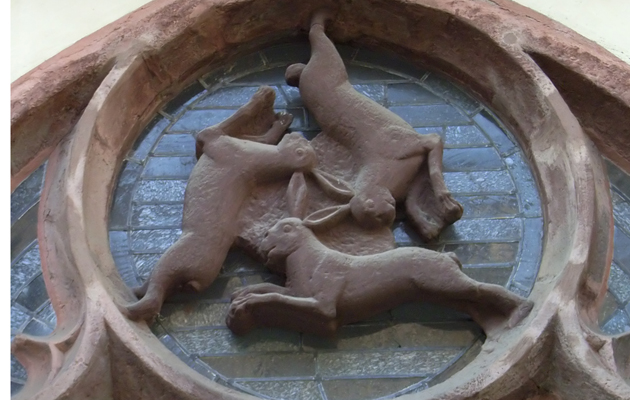
The 3 rabbits, is a symbol in churches in England and Germany but also
around the world.
The other "Rabbit Theory" was almost the opposite!! ...??
The Greeks believed that rabbits could multiply as virgins. This belief continued into Medieval times and monks would teaching children
would use the rabbit as a symbol of the Virgin Mary, and that they were sinless bunnies. They even concocted a "Father Rabbit" ..that would
hand out colored eggs to the kids when they could recite a bible verse or for just good behavior.
Did you Behave....?,
If so pick out an egg
|
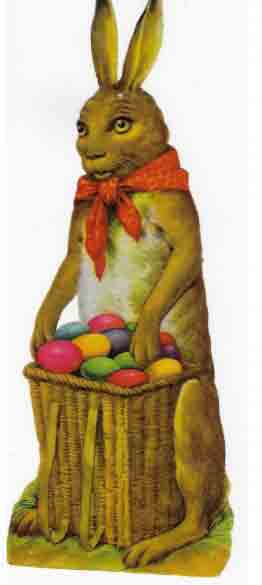 |
Even the eggs were not a fertility symbol but a result of more religion.
At the beginning of Lent (40 days before Easter) children would go
around and knock on doors asking for any extra eggs that would be
illegal to eat the next day. During lent eggs were wasted, but as
the Easter was getting closer they would boil the eggs so they would
be preserved for a big "Egg Feast"
in which many were colored especially red.
So why color the eggs and why red?
Did the decorating of eggs start with the celebration of Easter?
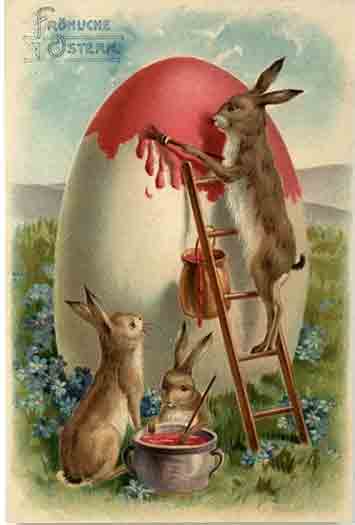 |
I read that they have been decorating eggs as far back as man gathered them
and figured out how to get colors from leaves and peels to express
their artistic feelings.
However in the Christian traditions eggs were colored red ...why?
There is a legend that Mary Magdalene went around announcing the resurrection
of Jesus and even went to the Roman Emperor. In disbelief he said "Jesus couldn't
rise from the dead," and he pointed to an egg on his table, "just as I couldn't
turn this egg red." Immediately the egg turned bright red!
|
Another story talks about hiding eggs in the bushes for kids to find, as eggs were plentiful after Lent.
Hunts are fun and so the bushes were a good place to find them.
Once the kids saw a bunny come out of the bushes and they thought it had laid the colored eggs.
Word spread and became a fantastical story to good to be proved wrong.
|
 |
Links for fun articles about Easter,
Rabbits and Hares, Eggs and other Goodies
This is from the Website The German Way
Some Easter Dishes for any Meal
~~~~~~~~~~~~~~~~~
Osterbrot or Hefekranz
Easter Bread ..or Braided Crown Bread
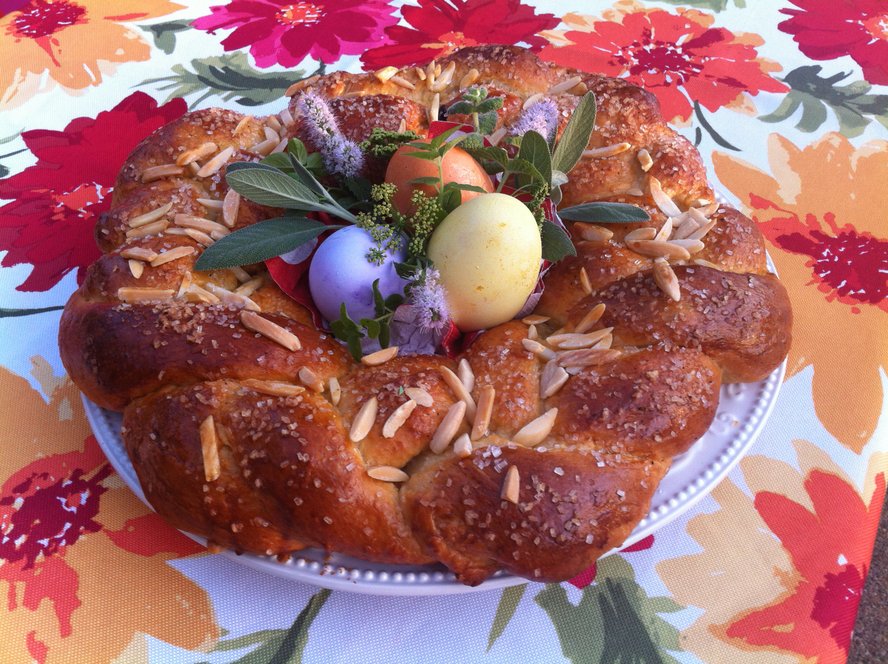
also called Hefekranz, this is like a Stollen only shapped in a crown.
This is a fun bread to make and takes not much work. The braiding is easy and you just form it
into a crown.
Go here to make Osterbrot or Hefekranz
for Easter or any celebration!
  
Zwiebelkuchen with Spinat
German Quiche style with Onions and Spinach

Our Germanrelatives from way back celebrated Easter and the Spring with egg dishes
that were not allowed during Lent. This was the rule of the land and not just for Catholics.
I still think it is fun to think of my great aunts and uncles, great grandmas and grandpas that
used up eggs hundreds of years ago about this time and made some wonderful dishes
that were welcome after a harsh winter.
About Zwiebelkuchen...
This is similar to a Quiche, only filled with lots of sweet sauted onions, Spinach and a bit of bacon. Sometimes folks use cheese and other times they don't.
There are many recipes for Zwiebelkuchen that is more like a pizza.
This is from the region of Baden in southwest Germany, where my grandmother is from. it is a cousin to Quiche Lorraine for sure as this Northeastern part of France has been pulled back and forth by the French and Germans through several wars.
There are 2 extraordinary taste sensations in this. One is the delicate custard texture, that is Quiche Lorraine and not just an solid Fritatta like texture, and the simmered onions in butter till they are sweet, with a little bacon that a word like "Zwiebel"
describes well.
Sometimes if we are watching carbs and calories we cut the crust out.
So I will show you you can go both ways.
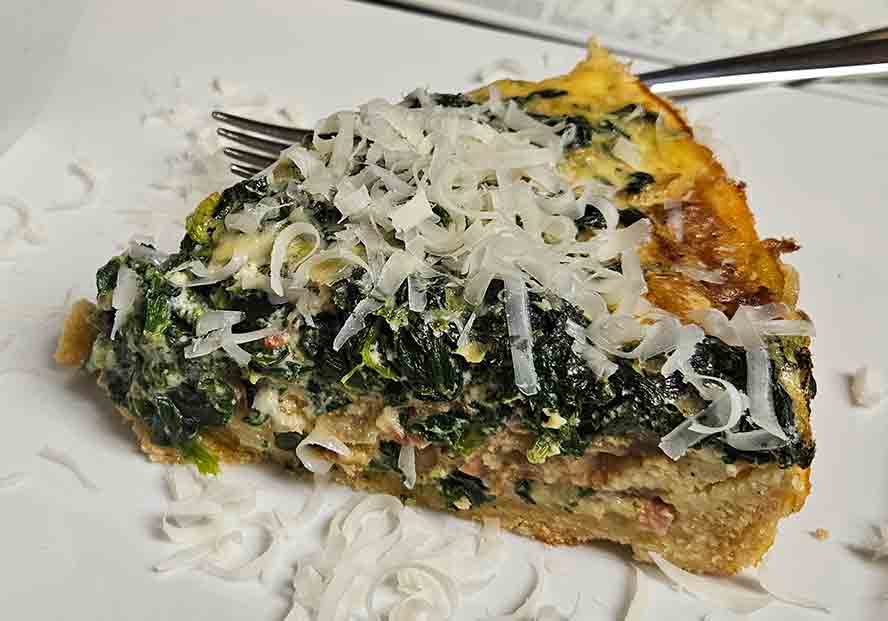
Go here to make Zwiebelkuchen with Spinat
with step by step pictures
  
Our German Cookbook
A recipe book and short biography of my Grandmother Emma Block. Her recipes, culture and cooking styles that were brought over from Germany. How they evolved when she came to America in the early 1900s and settled in Portland, Oregon on the west coast of the United States. Over 100 recipes
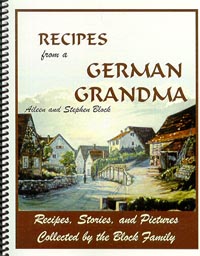
|
Bonus Recipe CD with the Ebook and recipes with step by step pictures

|
|

Order the Kindle Version |
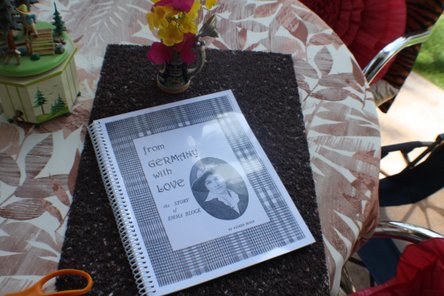 \ \
Biography of my grandma
Emma Block
From Germany with Love tells the story of my grandma, Emma Block, growing up in a little town in Baden/ Würtemberg, Germany near Heidelberg named Steinsfurt. Then at the age of 15 immigrating to the United States, taking a train with one of her sisters and brothers to Hamburg and sailing the Atlantic with other hope filled Germans wanting to make a life in the "New World". It was not easy but with good values learned in her German upbringing made a full life, had a wonderful family with lots of fun and celebration including the great German meals.
Order Here
15.97 |
|
  
Arme Ritter
German Style French Toast
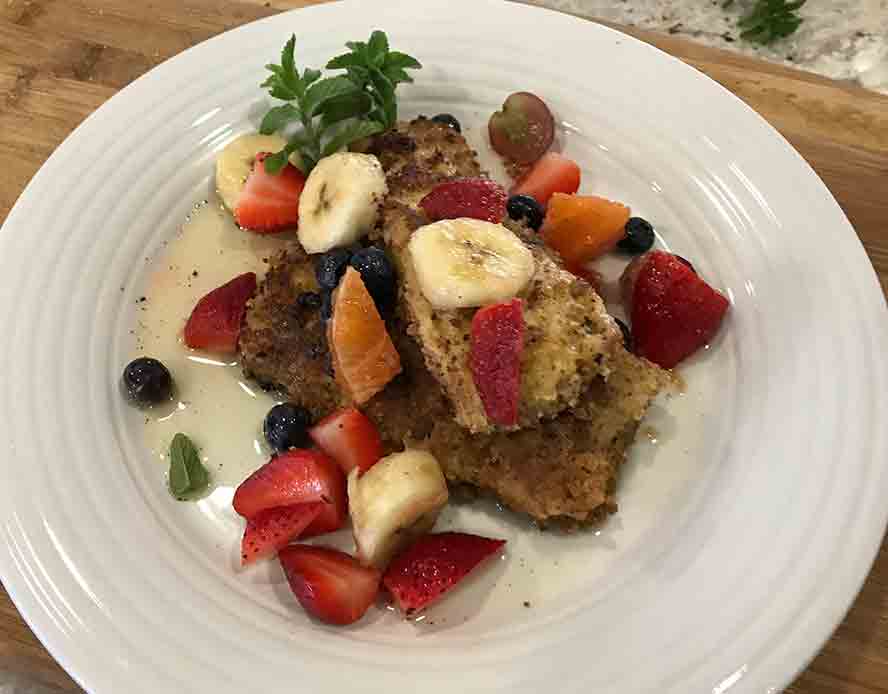
Arme Ritter literally means "Poor Knight" in German
and if you put into a translator "Armer Ritter" then it returns "French Toast".
To learn more about the history of Arme Ritter
and French Toast go here.
Making Armer Ritter is not much different than making French Toast except this particular German recipe calls for breading it in bread crumbs. 2 things Old German house holds had was stale bread and bread crumbs. Nothing was wasted.
This recipe is adapted from the DDR museum website
They soak the bread in the milk first then dip it into the egg which you find this technique in a lot of German recipes to bring stale bread to life as a binder or for dumplings to mention a few. The other thing is that they used a bit of grated lemon peel in the dip.
Go here to make Arme Ritter
or
German French Toast
  
Eggs Ala Goldenrod
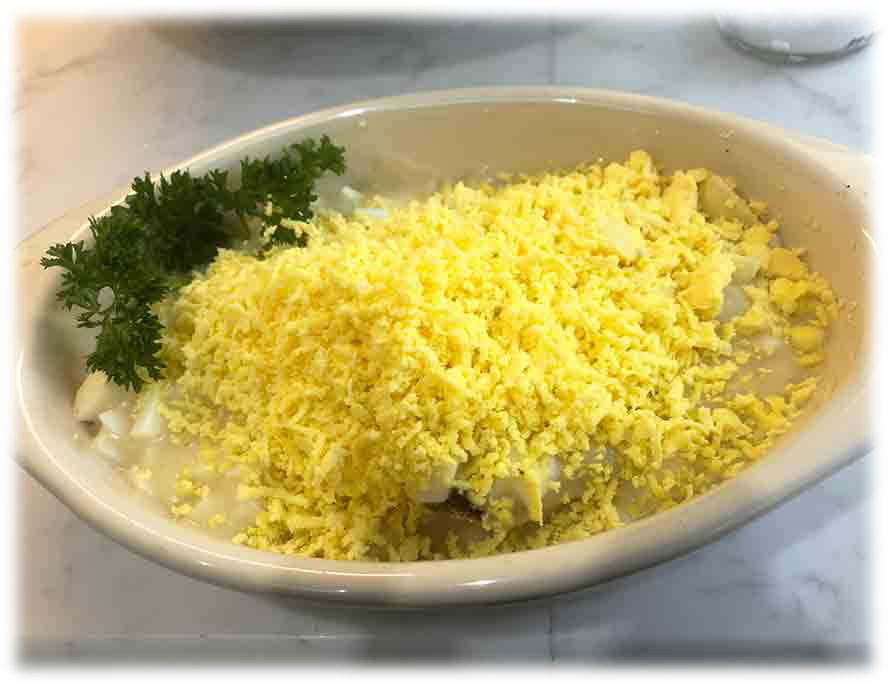
This is a wonderful dish made with hard cooked eggs and a creamy white sauce poured over toast triangles.
You grate the hard cooked yolk over the top for a garnish. It is not especially a German dish, although
eggs
on toast surely is. It has always been a special dish for me since my young adult life.
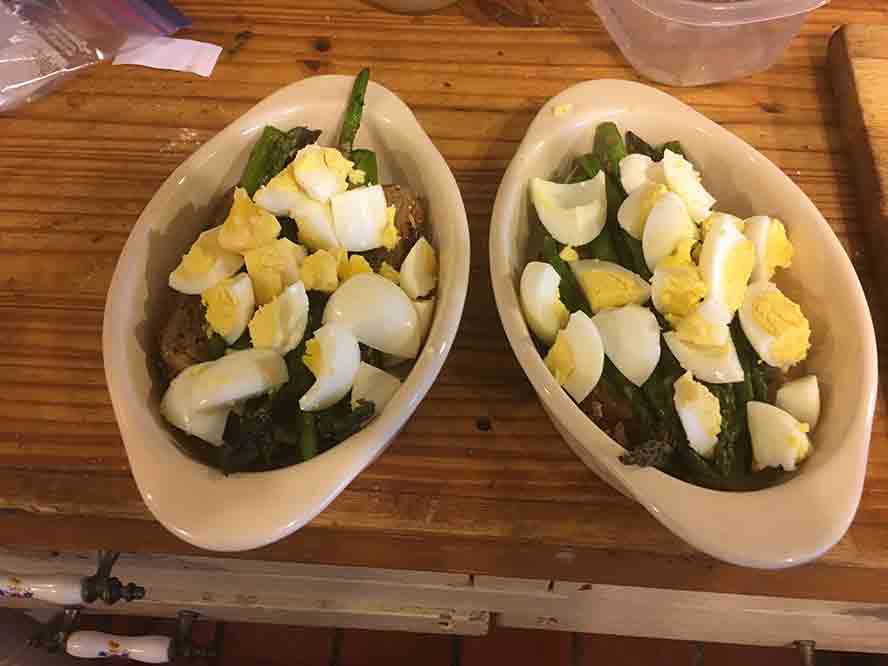
You can of course add asparagus or spinach to this simple dish.
Go here to my Food History website to read and make
Eggs ala Goldenrod.
  
Funny Bunny Treat Bags
a cute bag you can make that you can hide treats in.

Introducing my wife Judy Q Block
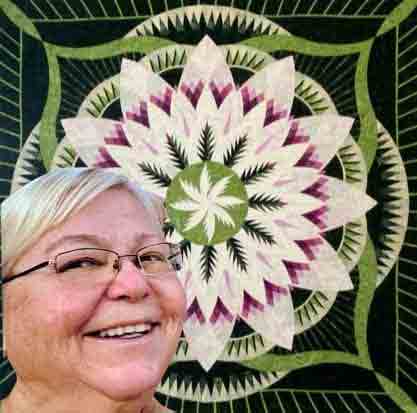
She is an professional instructor of Quilting
and a lifetime sewing enthusiast that has created many cool creations with
fabric and thread.
I have wanted to introduce for some time now, when I heard that young folks that
have spent most of their life in front of a computer screen.
They can also work a gaming joystick well but they are hungry now to
learn other crafts, including sewing.
We are thinking of dedicating a good share of our remaining years to helping
young folks learn to cook and sew.
She worked up this Funny Bunny creation
for this newsletter and for my grandkids
for their Easter celebration
this year.
So she is offering this pattern that you can download
and then cut out and lay on the fabric, cut out and a few simple stitches
to create this wonderfull gift.

|
Through modern technology we can enjoy music from Germany at the touch of your computer, there are many venues now, Pandora, Amazon music, and Youtube is free.
I love my noise canceling headphones that are completely wireless and give incredible sound! |
 
Bose Headphones
over 2500 perfect reviews, it is a bit of an investment but worth every penny. |
 
Round Spaetzle Pan
stainless steel
with Scraper
I like this round version of the spaetzle tool as it fits nicely on a pot. Many great reviews on this pan.
|
 
Westmark Spaetzle press
This is a wonderful tool from Germany, that makes the longer Spaetzle noodles. My German friend brought one over from Germany for me.
|
|
|